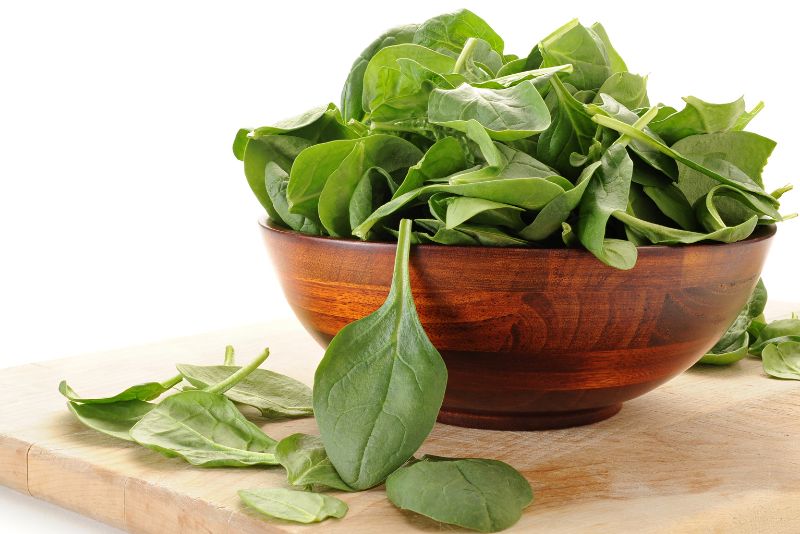Spinach is a leafy green vegetable. These days, it’s hard to find a dish that doesn’t contain spinach. It’s in salads, smoothies, and even pasta dishes.
However, there are some people who can’t eat spinach because they don’t like the taste of spinach or they’re allergic to it or they can’t find fresh spinach, or have other health reasons for avoiding it.
Whatever your reason is, there are many spinach substitutes that you can use.
In this blog post, I’ll cover 11 closest substitutes for spinach that are at least as healthy as spinach and might even taste better.
Table of Contents
11 Best Spinach Substitutes
The best substitutes for spinach are Romaine lettuce and escarole. You can also use Kale, collard greens, and Swiss chard as spinach alternatives in most recipes.
Keep reading to find more vegetables similar to spinach and why they might be a better pick for you.
1. Romaine Lettuce
Romaine lettuce is a type of cos lettuce. It has long, crunchy outer leaves and pale-colored tender inner leaves.
It is part of the “Lactuca Sativa” species. Just like other types of lettuce, it contains high concentrations of antioxidants and flavonoids. It is also high in vitamin A and low in calories.
Romaine lettuce is probably the closest alternative to spinach in terms of look, feel and taste. It can be eaten raw in salads or cooked/steamed for a few minutes.
Romaine lettuce is a great addition to salads since it has a nice crunch that spinach doesn’t have.
2. Escarole
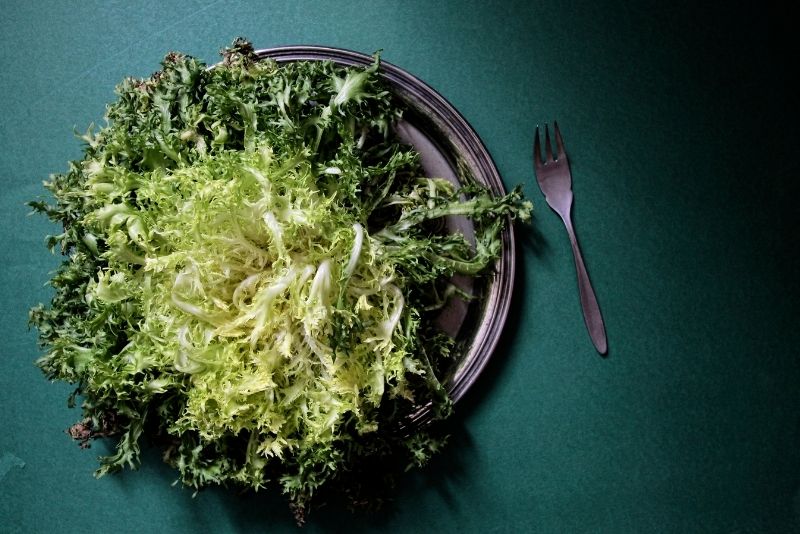
Escarole is a leafy green vegetable that belongs to the endive family. It has a slightly bitter taste and dark leaves.
It is low in calories and fat, but high in fiber, vitamin A, and folate. It is also a good source of calcium.
Escarole can be used as an alternative to spinach, especially in salads and pasta dishes. It’s very similar to spinach because it has thinner leaves than lettuce. The edges are slightly curly so it makes for an even better substitute.
Escarole tastes a lot like spinach, but it has a bit of a bitter taste to it. It’s a great substitute because it adds a nice texture to salads.
3. Collard Greens
Collard greens are part of the brassica family. It’s a leafy green vegetable that has flat, green leaves.
It is low in calories and fat, but high in fiber, calcium, iron, and other nutrients. It also contains antioxidants to fight diseases.
Collard greens are great if you want to make your own version of “southern-style” dishes. It’s a great spinach substitute in a vegetable lasagna or even a red velvet cake.
Collard greens taste a lot like spinach and it has the same texture and can be used as an alternative if you’re looking to add more flavor to your dishes.
4. Kale

Kale is part of the brassica family as well. It has green curly leaves that are packed with nutrients. Just like collard greens, it is low in calories and fat but high in fiber.
It is also rich in iron, magnesium, calcium, vitamin K and other antioxidants. One cup of kale contains 7 grams of protein.
Kale can be used as an alternative to spinach because it works well in a lot of dishes. It can be boiled, steamed, or even added to a smoothie.
The taste is similar to spinach as well so if you’re looking for a lightly flavored option, then kale may just be the one for you.
5. Swiss Chard
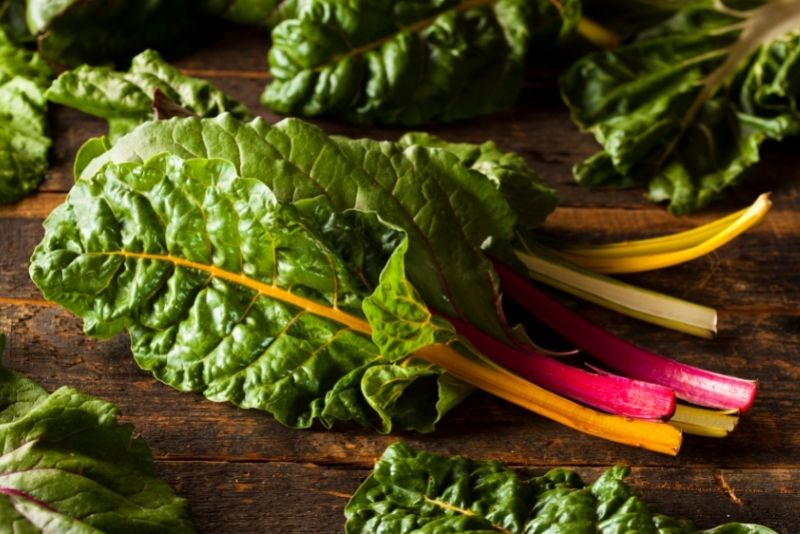
Swiss chard belongs to the beet family and is a type of beetroot. It has green and sometimes red stems and green leaves.
It contains high concentrations of antioxidants, vitamin K, magnesium, and fiber. Just like kale, Swiss chard is rich in iron as well as vitamins A and C.
Swiss chard can be a good spinach alternative because it’s slightly crunchier. It can be used in pasta dishes and salads.
The taste is slightly sweeter than spinach, but it’s pretty similar to the original. Swiss chard works really well as a salad substitute because of its crunchy texture.
6. Arugula
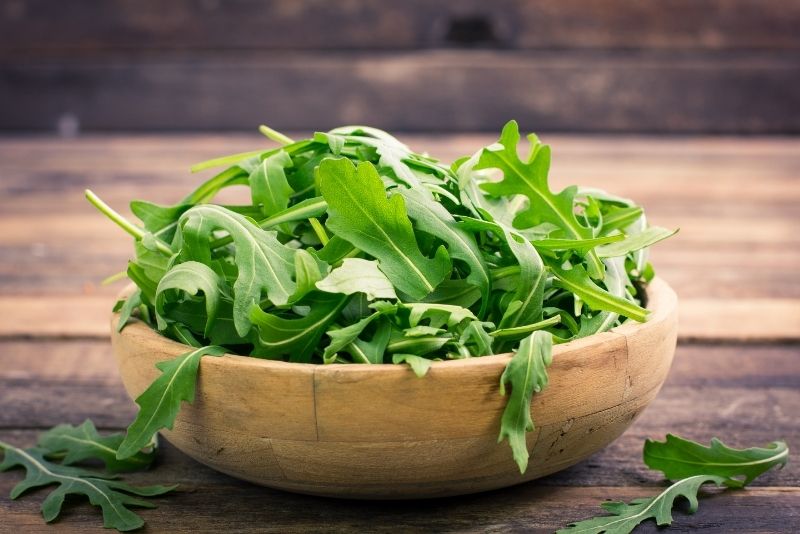
Arugula belongs to the cruciferous family and comes from the mustard plant. It has a slightly bitter taste and dark green leaves.
It is low in calories and fat, but high in fiber, calcium, iron, and antioxidants. One cup of arugula contains 8 grams of protein.
Arugula can be used as a substitute for spinach and it works well with pesto or pasta dishes.
The taste is a bit ‘spicier’ than other options because of its unique flavor. It’s a great alternative if you’re not a fan of spinach but still want to add more flavor to your dishes.
7. Iceberg Lettuce
Iceberg lettuce belongs to the brassica family. It has light green leaves that are sturdy and crunchy. Iceberg lettuce is very low in calories, fat, and nutrients.
Although this vegetable is very low in nutrients, it’s great if you want a crispy addition to your salads. Iceberg lettuce also works well as a spinach substitute in sandwiches because of its crunchy texture.
The taste is similar to spinach with a light, crisp flavor. Iceberg lettuce is easy to find at grocery stores and supermarkets so it’s a great option if you want a middle ground between iceberg lettuce and romaine lettuce.
8. Curly Endive
Curly endive belongs to the chicory family. It has yellow-green leaves that are curly and thin, unlike other vegetables from the chicory family.
It is low in calories, but high in fiber. Just like iceberg lettuce, it’s very low in nutrients. Curly endive can be great as a substitute for spinach because of its slightly creamy taste.
The leaves can be used in salads, soups, and pasta dishes. It is crunchy, but with a creamier texture than most other leafy green vegetables.
9. Watercress
Watercress is part of the cruciferous family and comes from the brassica genus. It has dark green leaves with large stems and a subtle taste.
Just like other leafy green vegetables, watercress contains antioxidants as well as vitamins K, A, and C. It’s low in calories and fat but high in fiber.
Watercress can be a great alternative to spinach because it’s slightly peppery. It works well in salads, sandwiches, and soups.
The taste is a bit bitter and earthy. Watercress is part of the cruciferous family, so if you’re not a fan of other vegetables from that genus then maybe watercress may not be for you.
However, watercress is a great option if you’re looking to add a peppery flavor to your dishes.
10. Cabbage
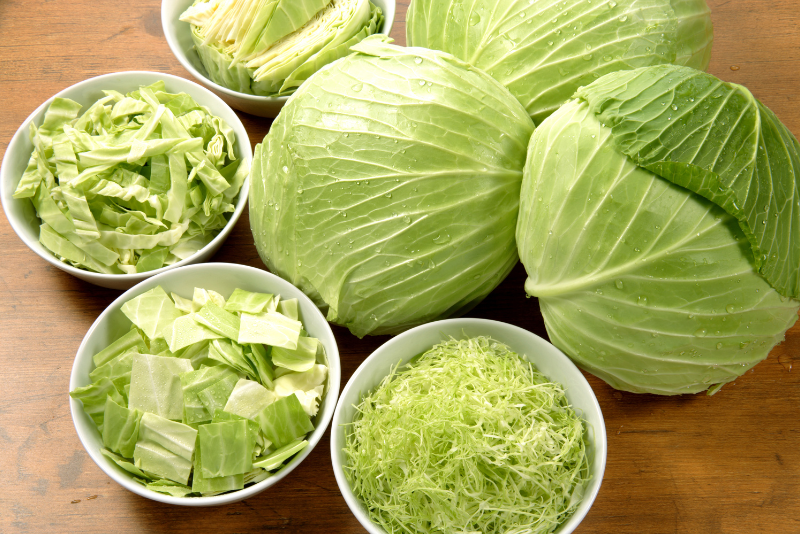
Cabbage is a popular cabbage vegetable that comes from the brassica family. It has green leaves and sometimes red veins.
Cabbage is low in calories but high in fiber and protein. I know what you’re thinking:
Is cabbage a good substitute for spinach because its leaves resemble those of spinach?
Well, cabbage can be a great substitute because the taste is similar. It works well in salads and as a sandwich filler.
It has a crisp texture with a ‘cabbage-y’ taste that may work better for people who don’t like other vegetables from the brassica family.
11. Beet Greens
Beet greens are part of the Amaranthaceae family. They have green leaves with red veins and long stems without a root attached.
These vegetables are high in antioxidants, iron, calcium, and fiber. Beet greens can be used as a substitute for spinach because they work well in salads, soups, and pasta dishes. The leaves are sturdy with a slightly earthy taste.
It can be difficult to find beet greens at grocery stores and supermarkets, but it’s worth the effort if you’re looking for a healthy option that’s also filling.
Frequently Asked Questions
What does spinach taste like?
Spinach has a slightly sweet taste, earthy taste. Some even find it to be savory. There is also a slight bitterness to spinach. Overall, spinach is a fairly mild-tasting green vegetable.
It’s crunchy and sturdy but can be difficult to digest if eaten raw. It works well in dishes like quiches, salads, or pasta because it absorbs flavors very well.
How long does spinach last?
Spinach will last for about 3-5 days in the fridge when stored in a moisture-proof, airtight container. If you plan on storing spinach for longer than that, it is best to freeze it. Frozen spinach can last for up to 8 months.
If your fresh spinach still has a root attached, it will last longer than spinach without a root. If the leaves are moldy, then it’s time to throw them away. Always clean fresh spinach as soon as you bring it home from the grocery store to avoid any bacteria or mold.
Be sure to use frozen spinach as soon as possible once thawed because there’s a possibility that bacteria could form due to the moisture content of the leaves.
What is healthier kale or spinach?
Spinach is healthier than kale because it has more nutrients. However, kale does have a higher amount of protein and iron.
Whether you choose spinach or kale as your go-to leafy green vegetable, just be sure to eat a variety of them for optimal health benefits.
Is spinach better raw or cooked?
Spinach is often used as a cooked vegetable, but it’s also delicious as a raw salad.
The texture of the leaves becomes softer and more delicate when cooked. It may be difficult to eat spinach raw because of its crisp texture and earthy taste.
Which spinach is the healthiest?
When it comes to the healthiest spinach, any type of fresh spinach will be great.
Just remember that smaller and younger leaves tend to have more nutrients than older and bigger leaves because their nutrient content hasn’t faded yet. Whether it’s organic or not is up to you and your budget.
Final Words
There are a lot of different leafy green vegetables that can be used in place of spinach.
The key is to find one that suits your needs and preferences, while still maintaining all the nutritional benefits you want from eating greens.
I hope this article has been helpful and informative. If you have any questions please leave a comment below and I’ll get back to you as soon as possible.
